.

Three Dakota men, seated or kneeling on ground, one attending to bison skull: Saliva, Slow Bull (in background), Picket Pin's arm: photo by Edward S. Curtis, c. 1907 (Edward S. Curtis Collection, Library of Congress))

The Oath -- Apsaroke. Three Apsaroke men [Goes Ahead (center) and Pretty Tail (left)] gazing skyward, two holding rifles, one with object skewered on arrow pointed skyward, bison skull at their feet: photo by Edward S. Curtis, 19 November c.1908 (Edward S. Curtis Collection, Library of Congress)

The offering -- Hu Kalowa Pi ceremony; Teton Indian, Slow Bull (?), holding pipe (?) on side of bison: photo by Edward S. Curtis, 1907 ( (Edward S. Curtis Collection, Library of Congress)

Hu Kalawa Pi, the altar complete: three Native Americans, Slow Bull, Saliva, and Picket Pin, kneeling with bison skull: Edward S. Curtis, 1907 ( (Edward S. Curtis Collection, Library of Congress)

1867 -- The evolution of the West in four decades -- 1907: J.L. Loveday, c. 1906 (Library of Congress)

[Indians hunting bison on horses covered with bison skins]: Frederic L, Remington, 1908: photo by P. F Collier for Detroit Publishing Company, c. 1908 (Library of Congress)

Doomed: Charles Schreyvgel, c. 1901 (Library of Congress)

[American Indian man on horseback killing bison]: Augustus Kollner, 185(-] (Library of Congress)

Pan-American [illustration showing Columbia and another woman, possibly representing South America, riding side-saddle on a Buffalo to the Pan-American Exposition in Buffalo, New York]: Udo J. Keppler, from Puck, 8 May 1901 (Library of Congress)

The Great Pawnee Bill shows. The only genuine wild west. Touring America ...: circus advertisement, c. 1903 (Library of Congress)
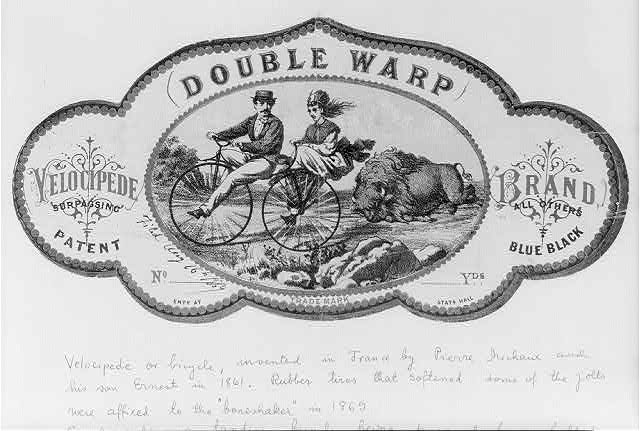
Advertising label for Double-warp Velocipede Brand fabric, showing bison pursuing couple on bicycle-built-for-two: c. 1869 (Library of Congress)

American bison: photo by Pelck's Scenic Art & Studio, c. 1906 (Library of Congress)

Last remnants of the American Bison, Yellowstone National Park: photo by American Stereoscopic Company, c. 1903 (Library of Congress)

The Lucky Buffalo Hunter: photo by Truman Ingersoll Ward, c. 1897 (Library of Congress)

American Bison on the obverse of 1901 U.S. $10 note: image by Red devil, 11 February 2006
Buffalo shot while running through corral: photo by Department of the Interior/U.S. Fish and Wildlife Service, Albuquerque Regional Office, Wichita Mountains Wildlife Refuge, 1936 (National Archives and Records Administration)

Animated sequence of a buffalo (American Bison) galloping : photos by Eadweard Muybridge, from Animal Locomotion, Philadelphia, 1887; animation by Waugsberg, 16 July 2007

Edward Estlin Cummings: Buffalo Bill's/defunct, from Seven Poems in The Dial, January 1920 (image by Blankfaze, 2005)
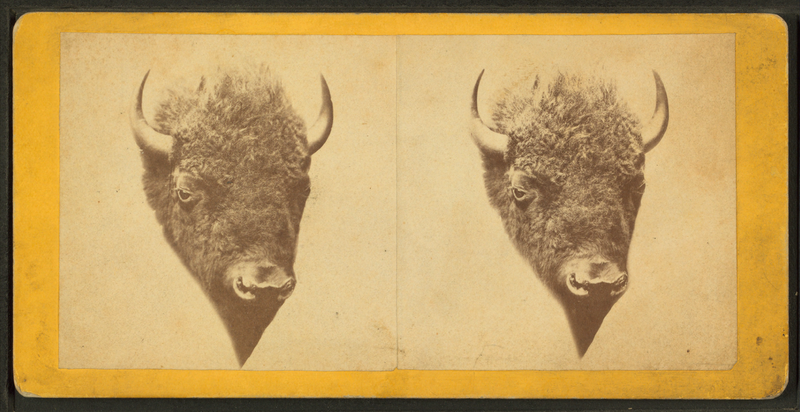
Head of a buffalo: photographer unknown, 1870s, Robert N. Dennis collection of stereoscopic views (Stephen A. Schwarzman Photography Collection, Miriam and Ira D. Wallach Division of Art, Prints and Photographs, New York Public Library)
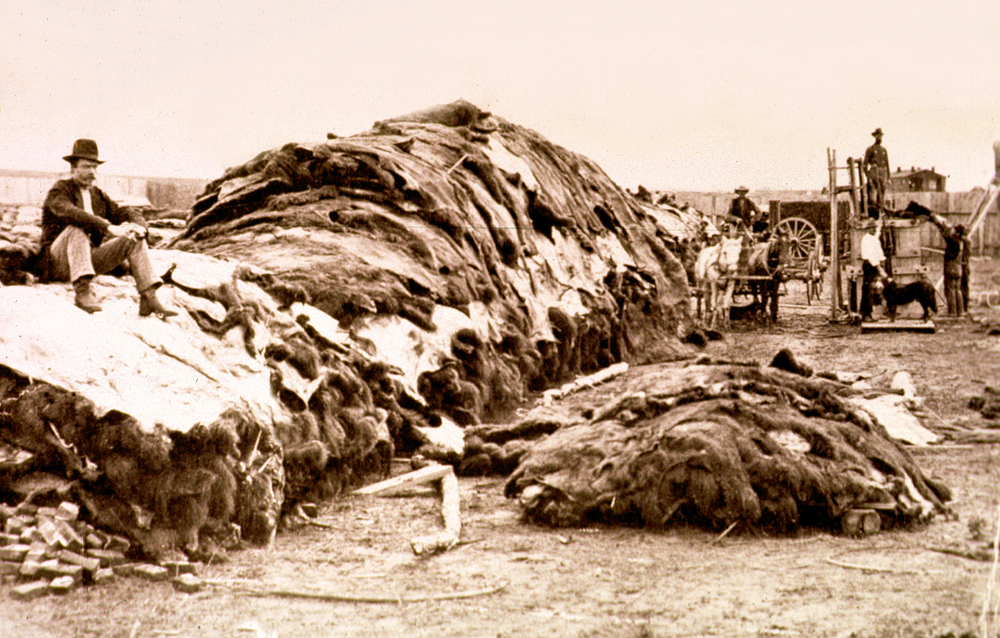
A stack of buffalo hides at a Dodge City hide yard. Commercial buffalo hunters slaughtered the animals by the thousands and left their carcasses to rot on the Plains: photographer unknown, c. 1870s (Kansas State Historical Society)
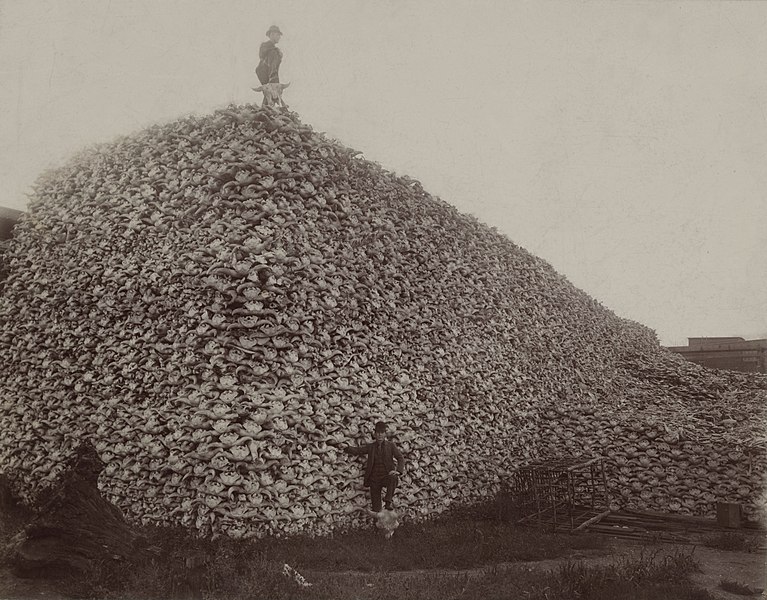
A pile of American Bison skulls waiting to be ground for fertilizer: photographer unknown, mid-1870s (image by Chick Bowen, 27 May 2011)
Of all the quadrupeds that have lived upon the earth, probably no other species has ever marshaled such innumerable hosts as those of the American bison. It would have been as easy to count or to estimate the number of leaves in a forest as to calculate the number of buffaloes living at any given time during the history of the species previous to 1870. Even in South Central Africa, which has always been exceedingly prolific in great herds of game, it is probable that all its quadrupeds taken together on an equal area would never have more than equaled the total number of buffalo in this country forty years ago.
.
During the two great periods of slaughter -- 1870-’75 and 1880-’84 -- the principal killing grounds were as well known as the stock-yards of Chicago. Had proper laws been enacted, and had either the general or territorial governments entered with determination upon the task of restricting the killing of buffaloes to proper limits, their enforcement would have been, in the main, as simple and easy as the collection of taxes. Of course the solitary hunter in a remote locality would have bowled over his half dozen buffaloes in secure defiance of the law; but such desultory killing could not have made much impression on the great mass for many years. The business-like, wholesale slaughter, wherein one hunter would openly kill five thousand buffaloes and market perhaps two thousand hides, could easily have been stopped forever. Buffalo hides could not have been dealt in clandestinely, for many reasons, and had there been no sale for ill-gotten spoils the still-hunter would have gathered no spoils to sell. It was an undertaking of considerable magnitude, and involving a cash outlay of several hundred dollars to make up an “outfit” of wagons, horses, arms and ammunition, food, etc., for a trip to “the range” after buffaloes. It was these wholesale hunters, both in the North and the South, who exterminated the species, and to say that all such undertakings could not have been effectually prevented by law is to accuse our law-makers and law-officers of imbecility to a degree hitherto unknown. There is nowhere in this country, nor in any of the waters adjacent to it, a living species of any kind which the United States Government can not fully and perpetually protect from destruction by human agencies if it chooses to do so. The destruction of the buffalo was a loss of wealth perhaps twenty times greater than the sum it would have cost to conserve it, and this stupendous waste of valuable food and other products was committed by one class of the American people and permitted by another with a prodigality and wastefulness which even in the lowest savages would be inexcusable.
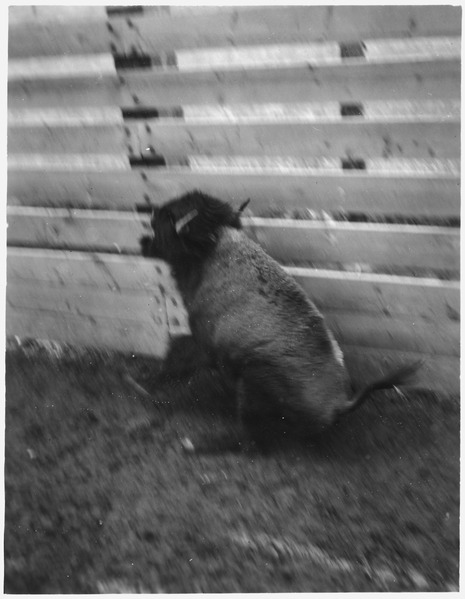
go figure. america, wasting. seems synonymous.
ReplyDeleteOne nation indivisible in species destruction for random dickhead pleasure and petty profit on the hide and tongue.
ReplyDeleteAll nobly memorialized on money, our traditional heritage site.
Some of those heroic buffalo bills with the sharps .50 caliber longrange big-game guns managed to knock off up to 5000 bison apiece.
A buck and a quarter for a tongue, another buck or two for the hide, and leave the rest on the prairie to rot.
Mass murder is always difficult to mechanize, however. There will always be the leftovers you can't kill, so pay off the Indians with firearms and whisky to do the dirty work for you.
The Indians thought the supply was an infinite gift of the higher power.
They were dupes to the slaughter.
In the end professional bounty hunters, mostly half breeds, finished off the last of the great herds in a very few short years.
Those who were skilled at the job were renowned for being able to blow away several of the continent's most majestic land animals with a single high-impact shot.
They became sheriffs and justices of the peace after the herds were all gone.
Tom,
ReplyDeleteBison on the plains, White Deer in GGNRA, story continues. . . .
9.21
grey whiteness of fog against invisible
ridge, drop falling from cypress branch
in foreground, sound of wave in channel
an object, but as dimension
in ‘field of presence’
goes, plays part, something
that can be seen from
silver of sunlight reflected in channel,
shadowed canyon of ridge across from it
Steve,
ReplyDeleteThe American Bison roaming the conservation areas in very small groups today, in the ‘field of presence’, are specimens of a thinned-out genetic strain, product of the random accidental interbreeding of domestic cattle with a few isolated and inbred individuals that, in "protected" areas (mainly Yellowstone National Park), managed to survive the slaughter that was more or less complete a few decades before the turn of the last century. The resemblance to the animals of the great herds of immemorial times is indeterminate. We'll simply never know. They simply never knew. What hit them.
That pile of skulls and final paragraph are deeply haunting.
ReplyDeleteWell there was no spirit to stop this in 1889, and the only difference today is that some people find it symbolically upsetting because of the buffalo's connection with American history. Of course the buffalo themselves didn't give two hoots for that. Nowadays there are sentient creatures being killed by the billion every what...week? day? I don't know, but it's a lot. The only thing that will stop it - and more importantly really, stop the cruelty in the way these creatures are treated while they're alive - is when people decide that animals have the same rights as humans. It's going to happen, but it won't be in my lifetime.
ReplyDeleteArtur.
Brad, I felt likewise. The Hornaday report is rich with dolorous detail of the slaughter. It makes for tears of woe and rage.
ReplyDeleteArtur, I could not agree more with those sentiments. But I wish you a long lifetime, and if during it the end you propose does not materialize, that certainly will not be because you have failed to do your part.
Coincidentally there spring to mind the colloquial phrases "to buffalo" and "to be buffaloed".
The Bison were utterly pacific creatures until taught fear of their unnatural adversary, well too late.
Any self-respecting goat would not have stood for it.
"The Indians thought the supply was an infinite gift of the higher power.
ReplyDeleteThey were dupes to the slaughter."
and now it's our turn.
i hear rick perry is holding a prayer meeting for rain again. if you cut funding to fire departments, make up for lack of man power with fervent prayer. if the heavens open and rain descends then texas is still on the right hand side of god. if the wind picks up and fire engulfs more and more lone state burning - well, there must be more gay folk in texas than are manning up and admitting..
The final and most brutal chapter in the extermination of the buffalo came in the years 1870-1874 in the Texas Panhandle. If Rick "I'm a Prick for Prayer and Profit" Perry were aware of that fact, he'd no doubt get down on his knees before the Big Guy, kack up a few hallelujahs and grab another ten points in the polls for the performance.
ReplyDeleteIt's probably safe to say however that he knows nothing of history at all. Why bother learning something you're doing your best to throw out the window. Replace it with old time stand-up-comedy elmer gantry medicine show religion (that is, cynical, hypocritical Texas good ol' boys-in-the-hunting-blind-talking-politics).
The pile of bison skulls haunts me, just as the photo of the slaughtered Native Americans at Wounded Knee.
ReplyDeleteA. said the photo made her think of Pol Pot's bone fields.
ReplyDeleteThere's a young (to me, anyway) man of my acquaintance who was born in one of Pol Pot's camps. Now he has just become a father.
Do flowers spring from the site of the Bison skull pile...?
Heartbreaking and very much in line with the way this country is and always has been.
ReplyDelete"wameles"
The skulls keep piling up, under bug-infested blankets, in the vacant shop doorways, on the lost avenue of the night.
ReplyDeleteToday's example would be "fracking" to get the natural gas out of the ground. Exploit any resource til exhaustion and then move on, leaving the destruction behind for others to live with. God help us, we haven't learned a thing.
ReplyDeleteMichael, yes, "fracking" is a practise in the great American tradition of Bison slaughter.
ReplyDeleteAnd then there's "mountaintop removal mining".
In the Land of the Free, everything is free for the taking, the killing and the otherwise destroying. Just so long as there's a buck to be made.